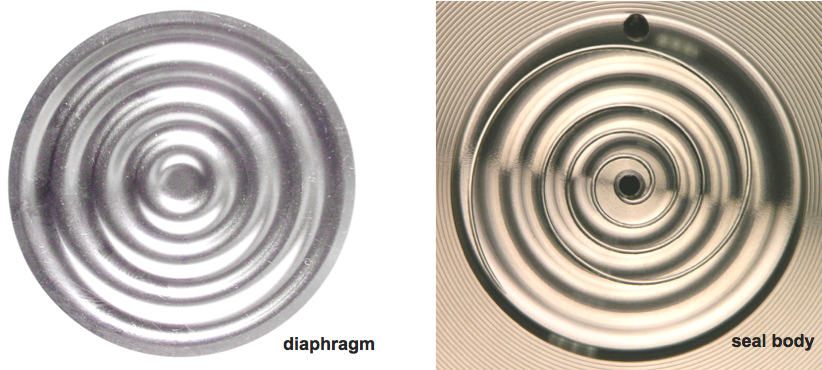
Diaphragm seals are a common accessory for pressure gauges and sensors in many refining and manufacturing applications. The pressure of the media being measured bends the flexible diaphragm slightly inward, and this movement displaces the fluid behind the seal into the instrument to create a pressure measurement reading. With a diaphragm seal, a thin metal diaphragm protects the sensitive workings of the instrument from hot or corrosive media. The diaphragm itself is the most vulnerable point of such a system. This thin strip of metal is directly exposed to the process media, so it must be compatible with, or resistant to, the media. Diaphragms are vulnerable to damage from pressure spikes, extended periods of instrument over-pressurization, and mishandling during installation, calibration, or repairs. That’s why it is important for diaphragm seal materials to be carefully selected, and for the devices to be designed and manufactured to the highest standards. WIKA, a leader in the instrument industry, has focused significant resources on diaphragm seal design for several decades. It has led the way in developing important industry innovations, including protective diaphragm seal convolution pattern matching and the diaphragm monitoring system.
Diaphragm Seal Convolution Pattern Matching
WIKA engineers developed the idea of diaphragm seal convolution pattern matching some time ago, and this key protective innovation in diaphragm seal technology deserves some elaboration. The idea behind convolution pattern matching is to support the diaphragm so it is less susceptible to damage from pressure spikes or mishandling. When a diaphragm is fully engaged by an over-pressure scenario, it may come into contact with the back plate of the fluid chamber if the design allows. Design of the back plate determines the modes of failure in this scenario. WIKA diaphragm seals are built with back plates that limit the travel of the diaphragm. This allows the diaphragm to rest against the back plate when fully engaged. Both the diaphragm and the back plate have the same convolution (formed with ripples) pattern. When the diaphragm is fully engaged, it rests flush with the back plate of the fluid chamber. This pattern matching design provides continuous deformation protection to the diaphragm if it is fully engaged by the process. Keep in mind that deformation of the diaphragm seal can lead to problems such as non-linear or non-repeatable pressure readings. Another benefit of diaphragm seal convolution pattern matching is that less system fill fluid is required for the seal, resulting in a reduction of temperature effects. Hydraulic fluids typically expand as temperatures increase (due to difference in the thermal coefficient of expansion between fluid and metal), and this can lead to “thermal zero shift” in a pressure gauge or sensor. In other words, the starting point (the zero) of a pressure instrument is moved slightly by a notable change in temperature. This “shift” introduces error throughout the measuring range of the instrument. Pressure instruments can, of course, be temperature compensated over a specific range, but the bottom line is that fewer temperature effects mean more precise instrument readings. WIKA knows diaphragm seals. Let our engineers and expert technical support staff fill you in on the latest developments in diaphragm seal technology or answer any questions you have about temperature or pressure measurement solutions.

